2. 复旦大学环境科学与工程系, 上海市大气颗粒物污染与防治重点实验室, 上海 200433;
3. 华东师范大学地理科学学院, 教育部地理信息科学重点实验室, 上海 200241
2. Shanghai Key Laboratory of Atmospheric Particle Pollution and Prevention, Department of Environmental Science and Engineering, Fudan University, Shanghai 200433;
3. Key Laboratory of Geographic Information Science of the Ministry of Education, School of Geographical Sciences, East China Normal University, Shanghai 200241
氯霉素(Chloramphenicol, CAP)是一种广谱抗生素, 广泛应用于临床治疗及畜禽水产养殖, 还可用作动物生长促进剂.在传统废水处理中, CAP的去除技术主要包括化学沉淀、活性炭吸附、活性污泥降解等.但许多研究表明, 传统的污水处理技术对CAP的去除效率较低, 因此, CAP在水环境中广泛存在(Zhou et al., 2013).水环境中残留的CAP, 即使是痕量水平也可能对生态系统造成威胁(Xu et al., 2011; Yan et al., 2013).此外, CAP也是高毒性含氮消毒副产物卤乙酰胺的前体物(Chu et al., 2015; Chu et al., 2016), 通过对其进行有效去除, 可以减少消毒副产物的产生.所以, 开发出切实有效处理污水中CAP的方法迫在眉睫.
作为一种高级氧化技术, 电子束辐照通过辐射过程中所产生的高能电离辐射作用于废水水体, 同时产生氧化性和还原性的活性粒子(HO·、H·和eaq-)(式(1))(Wang et al., 2007), 可以有效去除难降解有机污染物.并且与传统废水处理方法相比, 电子束辐照具有无需或较少加入化学试剂、处理效率高及无二次污染等优点, 特别适用于传统方法难以处理的有机化合物, 如普里米酮(Liu et al., 2015)、邻苯二甲酸二甲酯(Wu et al., 2011)、卡马西平(Zheng et al., 2014)、毕克草(Xu et al., 2011)和四溴双酚A (李杰等, 2012)等.目前对电子束辐照技术降解水中有机污染物的研究多以纯水为基础(Peng et al., 2015;付兴明等, 2016), 例如, 已有报道显示, 应用电子束辐照技术可以有效去除纯水中的CAP(Zhou et al., 2010; Cho et al., 2015).然而, 实际水体中不仅含有待处理的污染物, 还有很多其他各种类型的共存物质, 包括一些共存离子和有机物等, 这些物质可能会抑制或促进降解体系的效率.Roshani等(2011)研究了电子束辐照降解苯并三唑, 发现一定浓度范围内腐殖酸(HA)会影响像水中苯并三唑的降解.水中的CO32-、HCO3-、NO2-和Cl-与HO·的反应速率较快, 而NO3-、NO2-和SO42-与eaq-的反应速率较快(Rivera-Utrilla et al., 2013; Buxton et al., 1988), 因此, 也可能会影响电子束辐照的降解效率.

|
(1) |
基于此, 本文通过实验考察水中CAP的电子束辐照降解过程, 探讨水中常见阴离子(Cl-、Br-、I-、CO32-/HCO3-、NO3-、NO2-和SO42-)和HA对CAP降解过程的影响, 并对比不同水体(去离子水、河水、湖水、海水、污水处理厂污水)中CAP的去除效果.此外, 有研究表明, 水中胶体所吸附的有机污染物的比例较高(Yan et al., 2013), 然而这些组分对有机污染物辐照降解的影响仍然不清楚.因此, 为了进一步明确水中胶体的影响, 将污水水样分离为过滤相、胶体相和真溶相, 探究电子束辐照体系对不同相态中CAP的去除效果, 以期为电子束辐照降解CAP提供理论依据, 同时为控制与消除水环境中的CAP污染控制技术开辟新思路.
2 材料与方法(Materials and methods) 2.1 实验材料CAP(纯度≥99.5%)购自百灵威试剂公司;甲醇(HPLC级)购自CNW公司;HA购自巨枫公司;其他试剂, 如Na2SO4、NaCl、NaHCO3、NaNO3、NaNO2、NaBr、KI、HCl、乙醇和NaOH等均至少为分析纯试剂, 购自国药集团化学试剂有限公司;高纯N2和N2O购自上海浦江特种气体有限公司;试验中溶液均使用去离子水配制, 溶液初始pH使用H2SO4和NaOH溶液调节.
2.2 实际水体的采集与处理实验涉及的实际水体包括河水、湖水、海水、污水处理厂污水, 水样带回实验室后立即用孔径为1 μm的玻璃纤维滤膜进行过滤.采用切向超滤装置(Pellicon System, Millipore)对污水的不同相态(过滤相、胶体相和真溶相)进行分离, 超滤方法参照本课题组前期工作中所述方法(Nie et al., 2014; Yan et al., 2016).
2.3 实验方法使用电子加速器(GJ-AII-electron accelerator, 上海先锋电机厂)进行辐照降解实验, 最大束功率2.0 MeV, 50 kW.辐照样品置于距电子加速器钛窗口30 cm处进行辐照, 电子束流强度为1 mA.样品体积为50 mL, 辐照吸收剂量设置为0.5、1、2、3和4 kGy.
2.4 分析方法CAP浓度采用高效液相色谱仪(HPLC, Ultimate 3000, Dionex, USA)测定, 色谱柱为XDB-C18(5 μm, 4.6 mm×150 mm), 流动相为甲醇:水(V/V, 60:40), 流速为0.8 mL·min-1, 进样量为20 μL, 检测波长为278 nm.溶液辐照前后溶液中的Cl-、NO3-和NO2-浓度采用离子色谱仪(IC)测定, 总有机碳(TOC)使用有机碳分析仪测定, CAP的降解产物采用气相色谱\\质谱联用仪(GC-MS, 7890A-5975C, Agilent, USA)进行分析, 具体分析方法和条件参照作者的前期工作(Nie et al., 2015).
2.5 反应动力学模型电子束辐照降解水中污染物时, 污染物的降解规律一般符合准一级反应动力学模型(式(2)), 因此, 本研究采用该模型来考察不同环境下电子束辐照对水中CAP的去除规律.

|
(2) |
式中, kobs为降解剂量速率常数(kGy-1), C0为初始浓度(mg·L-1), C为辐照后浓度(mg·L-1), D为辐照吸收剂量.
3 结果与讨论(Results and discussion) 3.1 CAP初始浓度对其电子束辐照降解的影响初始浓度C0对电子束辐照降解CAP的影响如图 1所示, 电子束辐照能够有效去除水中较宽范围浓度的CAP, 且CAP的降解率随着辐照剂量的增大而大幅增加, 但在同一辐照剂量下, CAP的降解率随着C0的提高而降低.
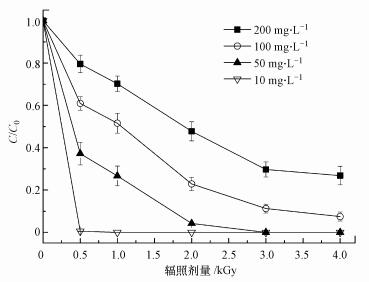 |
| 图 1 初始浓度对CAP的电子束辐照降解的影响 Fig. 1 Effect of initial concentrations on the degradation of CAP under electron beam irradiation |
经计算, C0为10、50、100和200 mg·L-1时, CAP的降解剂量速率常数kobs分别为10.4、1.5、0.7和0.4 kGy-1, 可决系数R2均大于0.98, 符合准一级反应动力学模型, 同时也说明电子束辐照对低浓度CAP的处理效果更好.辐照剂量为0.5 kGy, C0为10 mg·L-1时CAP的降解率为99.4%, 当辐照剂量≥1 kGy时, CAP的降解率可达100%.辐照剂量为2 kGy, C0为50 mg·L-1时CAP的降解率为95.7%, 而C0为100和200 mg·L-1时的降解率分别只有77.1%和52.2%.为了方便比较, 后续实验均用C0为100 mg·L-1的CAP溶液进行研究.
3.2 初始pH对CAP的电子束辐照降解的影响溶液初始pH对电子束辐照降解CAP的影响如图 2所示, CAP的降解率随pH值的升高而降低.辐照剂量为4 kGy时, 初始pH=3.1的CAP的降解率为98.7%, 而pH=11.1的CAP的降解率只有90.1%.有研究表明, 溶液pH值可以显著地影响辐照体系中活性粒子(HO·、H·和eaq-)的浓度.在酸性环境下, eaq-可以与H+反应生成H·(式(3))(Zheng et al., 2011), 虽然eaq-的数量减少了, 但也降低了eaq-与HO·的反应几率(式(4)), 从而使得体系中HO·浓度增加, 与HO·有关的反应增强(Liu et al., 2015).而在碱性环境下, 氧化性较强的HO·会解离成较弱的O·-(式(5))(Buxton et al., 1988; Poskrebyshev et al., 2002), 从而降低了体系中HO·浓度, 与HO·有关的反应被削弱.CAP的降解率随着pH值的升高而降低, 表明CAP的电子束辐照降解过程可能主要是通过与HO·反应完成的.Guo等(2012)也发现pH=3~9时, 磺胺嘧啶的辐照去除率可以达到90%~93%, 而pH=11.1时, 去除率有所降低.同样的, 3-氯-4-羟基苯甲酸(Chu et al., 2016)和甲硝唑(Sánchez-Polo et al., 2009)的gamma射线辐照降解在pH=4.0时最好, 而在pH=11.0时较差.
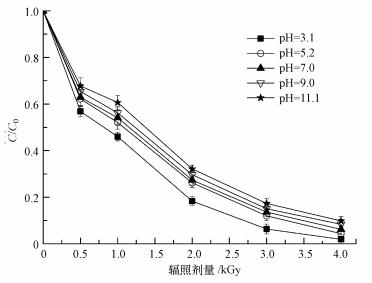 |
| 图 2 初始pH值对CAP的电子束辐照降解的影响(C0=100 mg·L-1) Fig. 2 Effect of initial pH on the degradation of CAP under electron beam irradiation |

|
(3) |

|
(4) |

|
(5) |
高速电子束辐照下, 水溶液主要产生3种活性粒子:HO·、H·和eaq-.为了进一步了解体系中哪种活性粒子对CAP的降解起主要作用, 考察了典型自由基清除剂对CAP辐照降解的影响, 结果如图 3所示.可以看出, 在N2O饱和体系中, CAP的降解率最高, 其次为空白体系(空气饱和), 再者为N2饱和体系, 第四为添加了10%乙醇的N2饱和体系, 最差的是在100%乙醇体系中.N2O饱和体系中, N2O可以与eaq-和H·反应生成HO·(式(6)~(7));而在空气饱和体系中, O2能与eaq-和H·生成O2·-和H2O2(式(8)~(9))(Zheng et al., 2011), 从而降低了eaq-与HO·相互反应的几率, 使得体系中HO·浓度增加, 与HO·有关的反应增强.由此可知, 体系中产生的HO·对CAP的降解起到了重要作用.在辐照降解毒死蜱(Ismail et al., 2013)、4-氯苯胺(Sanchez et al., 2002)和2, 4-二氯苯氧乙酸(Zona et al., 2002)的研究中, 同样发现N2O和O2可以促进这些污染物的降解.
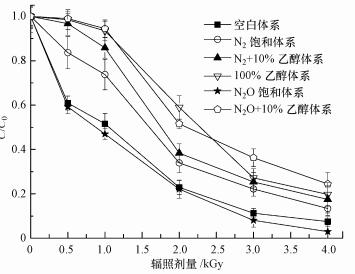 |
| 图 3 不同自由基清除剂对CAP电子束辐照降解的影响(C0=100 mg·L-1) Fig. 3 Effect of scavengers on the degradation rate of CAP under electron beam irradiation |

|
(6) |

|
(7) |

|
(8) |

|
(9) |
当N2饱和体系中加入乙醇时, CAP的降解率明显下降.乙醇与HO·的反应速率很高(k=1.7×109~2.2×109 L·mol-1·s-1), 是良好的HO·清除剂, 并且乙醇也可以与大部分H·反应(k=1.3×107~1.7×107 L·mol-1·s-1)(Buxton et al., 1988), 此时反应体系中eaq-是主要的活性粒子, 但结果表明CAP的去除率降低.因此, 虽然HO·、H·和eaq-对CAP的降解均有一定的贡献, 但相较而言, HO·起到了主要作用.此外, 在100%乙醇体系中, 随着吸收剂量的不断增大, CAP分子也会吸收辐照而发生分解.
3.3 共存物质对CAP辐照降解的影响 3.3.1 阴离子的影响本文考察了水中常见阴离子(Cl-、Br-、I-、CO32-/HCO3-、NO3-、NO2-和SO42-)存在时CAP的辐照降解情况, 其kobs变化如图 4所示.体系中添加阴离子均会抑制CAP的辐照降解, 并且阴离子浓度越高, kobs越小.不同阴离子对CAP辐照降解的抑制能力排序为:NO2->I->Br->CO32-/HCO3->NO3->Cl->SO42-.卤素离子中, I-和Br-是HO·的良好清除剂(k分别为1.2×1010和1.1×1010 L·mol-1·s-1), 分别可以形成IOH·-和BrOH·-, 后者演变成的Br·和Br2·-又可以扮演eaq-和H·的清除剂.Cl-可以与HO·发生反应(k=4.3×109 L·mol-1·s-1), 首先HO·将Cl-转变成ClHO·-, 随后ClHO·-可以通过去质子化反应快速地转化为Cl·.此外, ClHO·-可能会重新形成HO·, 也可能会与eaq-或H3O+反应生成Cl·, 因此, 会降低体系中的活性粒子浓度(Buxton et al., 1988; Atinault et al., 2008; Rivera-Utrilla et al., 2013).卤素离子的抑制能力排序为I-> Br-> Cl-, 这跟三者与HO·的反应速率常数大小有关.
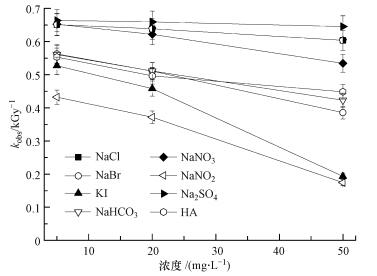 |
| 图 4 共存物质对CAP电子束辐照降解的影响(C0=100 mg·L-1, 辐照剂量0~4 kGy, 共存物质0~50 mg·L-1) Fig. 4 Effect of coexisting substances on the degradation rate of CAP under electron beam irradiation |
加入HCO3-后, 溶液的pH值会改变(pH=7.1~8.3).从3.2节的讨论结果可知, CAP在中性和碱性条件下的降解速率相较于其它pH值条件来说是偏低的, 因此, HCO3-可以通过改变体系pH值来抑制CAP的降解速率.此外, 在其他3种体系中, HCO3-和CO32-都可以强烈地与CAP竞争体系中的活性粒子, 如HO·(k分别为3.9×108和8.5×106 L·mol-1·s-1)和eaq-(k分别为6.0×105和3.9×105 L·mol-1·s-1).虽然HCO3-和CO32-可以与HO·生成活性较低的无机自由基, 如CO3·-和HCO3·(Buxton et al., 1988; Rivera-Utrilla et al., 2013).但这些新生成的自由基的氧化能力均无法与HO·媲美, 从而降低了体系的降解效率.
NO3-可以快速地与体系中的H·(k=1.4×106 L·mol-1·s-1)和eaq-(k=1.1×1010 L·mol-1·s-1)反应, 因此, 可以抑制CAP的降解(Buxton et al., 1988).而NO2-是一种非常高效的HO·(k=1.0×1010 L·mol-1·s-1)和eaq-(k=4.1×109 L·mol-1·s-1)的淬灭剂, 同时也可以与H·(k=7.1×108 L·mol-1·s-1)反应, 因此, 即使在低浓度下也可强烈抑制CAP的降解反应(Buxton et al., 1988).SO42-对CAP降解的影响较小, 这是因为虽然SO42-可以与eaq-反应(k < 1×106 L·mol-1·s-1), 但基本上不与HO·反应(Buxton et al., 1988).
总的来说, 阴离子的抑制能力与其跟HO·的反应速率常数有关, 并且该反应速率越大, 阴离子的抑制能力越强, 这也验证了体系中的HO·是导致CAP降解的主要活性粒子.如废水中与HO·反应速率常数较大的阴离子(如NO2-、I-和Br-)浓度较大, 需要提前处理, 否则将影响电子束辐照的处理效果.
3.3.2 HA的影响HA是天然有机质的主要成分, 由图 4可知, HA的加入能够影响CAP的去除.随着HA初始浓度从0 mg·L-1增加至50 mg·L-1, CAP的降解速率从0.66 kGy-1下降至0.45 kGy-1.HA含有大量的羧基和羟基官能团, 因此, 可以与CAP竞争活性粒子(Nie et al., 2015), 从而对CAP的降解产生一定的抑制作用.Roshani和Leitner(2011)同样发现当HA存在时, 电子束辐照下对苯丙三唑的降解速率有所下降.
3.4 实际水体中CAP的降解为了考察实际应用中电子束辐照技术去除CAP的效果, 选取了不同水体(去离子水、河水、湖水、海水、污水处理厂污水)进行试验.相关水质指标及CAP在其中的反应速率常数如表 1所示.实验结果表明, CAP在不同水体中辐照降解的速率为:去离子水>河水>湖水>海水>污水厂污水.这是由于实际水体中存在大量的有机物和各种离子, 会和CAP发生竞争反应, 消耗活性粒子, 因此, 抑制了CAP的降解, 并且水中Cl-和溶解性有机碳(DOC)含量越高, CAP的降解速率越慢.
| 表 1 不同水体的理化性质参数及CAP在其中的反应速率常数 Table 1 Basic physical and chemical characteristics of different water matrices and pseudo-first-order rate constant for degradation of CAP in these matrices |
虽然污水厂污水的CAP降解速率低于去离子水中的降解速率, 但辐照剂量为4 kGy时, CAP可去除89.1%, 这说明电子束辐照技术可以很好地应用在实际废水的处理中.污水中不同相态水体的CAP降解速率排列次序依次为:真溶相>过滤相>胶体相, 这与过滤相、胶体相中相对较高的DOC含量有关.虽然污水水体中胶体相CAP的氧化降解速率最慢, 但辐照剂量为4 kGy时, CAP去除率可达81.7%.在不同的污水处理技术中, 超滤、纳滤等膜分离技术以高效去除污水中的污染物而得到广泛的关注.然而, 膜分离技术并不能彻底地去除污水中的污染物, 并且如何去除由各种滤膜所截留下来的浓度高、毒性强的污染物废水也是一个难题, 这必然会增加处理的成本.而本研究发现, 胶体相中CAP的电子束辐照降解效果较好, 因此, 可以尝试将电子束辐照技术应用在膜分离技术的后续浓水处理中.
3.5 辐照中间产物的测定和TOC变化IC的分析结果表明, CAP辐照降解过程中有Cl-、NO3-和NO2-的产生, 其中, Cl-和NO3-的浓度随着辐照剂量的加大而升高, 而NO2-只有在辐照剂量较低时有检出, 这可能是因为较高的辐照剂量会将NO2-氧化成NO3-.实验还测定了辐照降解过程中TOC的去除率, 如图 5所示, 与CAP的去除率相似, 高辐照剂量的条件下, TOC的去除率也较高.但与CAP的降解不同, 辐照剂量为4 kGy时CAP可以去除92.5%, 而TOC的去除率只有14.3%, 这是因为CAP没有完全矿化, 大部分只是转化成了其他有机中间产物.
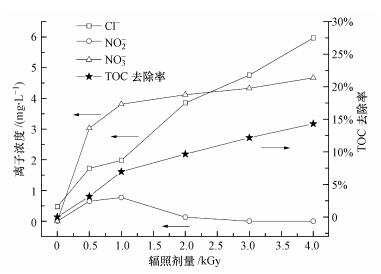 |
| 图 5 辐照前后CAP溶液中离子浓度和TOC变化(C0=100 mg·L-1) Fig. 5 Variation of anions and TOC in an aqueous CAP solution after electron beam irradiation |
通过GC-MS对CAP的辐照中间产物进行测定, 得到6种主要的中间产物, 降解产物信息列于图 6.Csay等(2012)观测到活性自由基优先攻击CAP结构中的芳环和两个不对称中心(a位置).在本研究中也发现, 大部分中间产物均是a位置断裂后形成的(产物Ⅲ、Ⅳ、Ⅴ和Ⅵ).同时, 也有b位置脱酰胺(产物Ⅱ)、c位置脱水(产物Ⅰ)作用生成的产物出现.这些有机中间产物在各种活性粒子的作用下, 会被进一步氧化成小分子有机物, 最终矿化成CO2、H2O和无机离子(如Cl-、NO3-和NO2-).
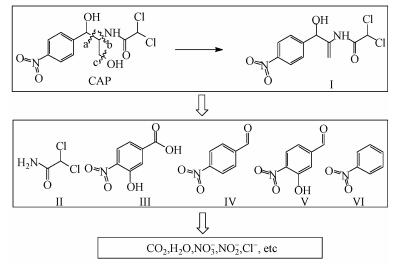 |
| 图 6 CAP电子束辐照降解的可能反应路径 Fig. 6 Proposed primary degradation pathway of CAP by electron beam irradiation |
1) 电子束辐照可有效去除水中CAP, 且降解过程符合准一级动力学模型.较低的CAP初始浓度和酸性条件有利于CAP的电子束辐照降解.
2) 自由基清除实验结果表明, 降解过程中HO·是导致CAP降解的主要活性粒子.
3) 水中共存的阴离子和HA对CAP辐照降解均有抑制作用, 其抑制能力排序为:NO2- > I-> Br-> HA > CO32-/HCO3- > NO3-> Cl-> SO42-.
4) CAP在不同水体中辐照降解的速率为:去离子水>河水>湖水>海水>污水厂污水.辐照剂量为4 kGy时, 污水厂污水过滤水和胶体浓缩液中的CAP分别可去除89.1%和81.7%.
5) 体系中共鉴定出6种中间产物, 主要是通过脱水、不对称中心断键和脱酰胺作用形成.产物中有二氯乙酰胺(产物Ⅱ)的产生, 具有潜在毒性, 因此, 后续工作需要对各产物的产率进行定量.此外, CAP辐照降解过程中有Cl-、NO3-和NO2-的产生, 并且TOC在一定程度上降低, 说明部分CAP被矿化.
Abdel daiem M M, Rivera-Utrilla J, Ocampo-Pérez R, et al. 2013. Treatment of water contaminated with diphenolic acid by gamma radiation in the presence of different compounds[J]. Chemical Engineering Journal, 219: 371–379.
DOI:10.1016/j.cej.2012.12.069
|
Atinault E, De Waele V, Schmidhammer U, et al. 2008. Scavenging of and OH radicals in concentrated HCl and NaCl aqueous solutions[J]. Chemical Physics Letters, 460(4): 461–465.
|
Buxton G V, Greenstock C L, Helman W P, et al. 1988. Critical review of rate constants for reactions of hydrated electrons, hydrogen atoms and hydroxyl radicals (·OH/·O- in aqueous solution[J]. Journal of Physical and Chemical Reference Data, 17(2): 513–886.
DOI:10.1063/1.555805
|
Cho J Y, Chung B Y, Hwang S A. 2015. Detoxification of the veterinary antibiotic chloramphenicol using electron beam irradiation[J]. Environmental Science and Pollution Research, 22(13): 9637–9645.
DOI:10.1007/s11356-015-4123-5
|
Chu L, Wang J. 2016. Degradation of 3-chloro-4-hydroxybenzoic acid in biological treated effluent by gamma irradiation[J]. Radiation Physics and Chemistry, 119: 194–199.
DOI:10.1016/j.radphyschem.2015.10.016
|
Chu W, Chu T, Bond T, et al. 2016. Impact of persulfate and ultraviolet light activated persulfate pre-oxidation on the formation of trihalomethanes, haloacetonitriles and halonitromethanes from the chlor (am) ination of three antibiotic chloramphenicols[J]. Water Research, 93: 48–55.
DOI:10.1016/j.watres.2016.02.013
|
Chu W, Krasner S W, Gao N, et al. 2015. Contribution of the antibiotic chloramphenicol and its analogues as precursors of dichloroacetamide and other disinfection byproducts in drinking water[J]. Environmental Science & Technology, 50(1): 388–396.
|
Csay T, Rácz G, Takács E, et al. 2012. Radiation induced degradation of pharmaceutical residues in water:chloramphenicol[J]. Radiation Physics and Chemistry, 81(9): 1489–1494.
DOI:10.1016/j.radphyschem.2012.01.021
|
付兴明, 罗敏, 马玲玲, 等. 2016. 电子束辐照降解水中氧氟沙星的研究[J]. 中国环境科学, 2016, 36(10): 3033–3039.
DOI:10.3969/j.issn.1000-6923.2016.10.028 |
Guo Z, Zhou F, Zhao Y, et al. 2012. Gamma irradiation-induced sulfadiazine degradation and its removal mechanisms[J]. Chemical Engineering Journal, 191: 256–262.
DOI:10.1016/j.cej.2012.03.012
|
Ismail M, Khan H M, Sayed M, et al. 2013. Advanced oxidation for the treatment of chlorpyrifos in aqueous solution[J]. Chemosphere, 93(4): 645–651.
DOI:10.1016/j.chemosphere.2013.06.051
|
李杰, 徐殿斗, 徐刚, 等. 2012. 四溴双酚A的辐照降解研究[J]. 环境科学, 2012, 33(5): 1587–1590.
|
Liu N, Wang T, Zheng M, et al. 2015. Radiation induced degradation of antiepileptic drug primidone in aqueous solution[J]. Chemical Engineering Journal, 270: 66–72.
DOI:10.1016/j.cej.2015.01.120
|
Nie M H, Yang Y, Liu M, et al. 2014. Environmental estrogens in a drinking water reservoir area in Shanghai:occurrence, colloidal contribution and risk assessment[J]. Science of the Total Environment, 487: 785–791.
DOI:10.1016/j.scitotenv.2013.12.010
|
Nie M, Yan C, Li M, et al. 2015. Degradation of chloramphenicol by persulfate activated by Fe2+ and zerovalent iron[J]. Chemical Engineering Journal, 279: 507–515.
DOI:10.1016/j.cej.2015.05.055
|
Peng C, Ding Y, An F, et al. 2015. Degradation of ochratoxin A in aqueous solutions by electron beam irradiation[J]. Journal of Radioanalytical and Nuclear Chemistry, 306(1): 39–46.
DOI:10.1007/s10967-015-4086-5
|
Poskrebyshev G A, Neta P, Huie R E. 2002. Temperature dependence of the acid dissociation constant of the hydroxyl radical[J]. The Journal of Physical Chemistry A, 106(47): 11488–11491.
DOI:10.1021/jp020239x
|
Roshani B, Leitner N K V. 2011. Effect of persulfate on the oxidation of benzotriazole and humic acid by e-beam irradiation[J]. Journal of Hazardous Materials, 190(1): 403–408.
|
Sanchez M, Wolfger H, Getoff N. 2002. Radiation-induced degradation of 4-chloroaniline in aqueous solution[J]. Radiation Physics and Chemistry, 65(6): 611–620.
DOI:10.1016/S0969-806X(02)00213-X
|
Sánchez Polo M, López Peñalver J, Prados Joya G, et al. 2009. Gamma irradiation of pharmaceutical compounds, nitroimidazoles, as a new alternative for water treatment[J]. Water Research, 43(16): 4028–4036.
DOI:10.1016/j.watres.2009.05.033
|
Wang J, Wang J. 2007. Application of radiation technology to sewage sludge processing:a review[J]. Journal of Hazardous Materials, 143(1): 2–7.
|
Wu M H, Liu N, Xu G, et al. 2011. Kinetics and mechanisms studies on dimethyl phthalate degradation in aqueous solutions by pulse radiolysis and electron beam radiolysis[J]. Radiation Physics and Chemistry, 80(3): 420–425.
DOI:10.1016/j.radphyschem.2010.10.008
|
Xu G, Bu T, Wu M, et al. 2011. Electron beam induced degradation of clopyralid in aqueous solutions[J]. Journal of Radioanalytical and Nuclear Chemistry, 288(3): 759–764.
DOI:10.1007/s10967-011-0986-1
|
Xu Y, Luo F, Pal A, et al. 2011. Occurrence of emerging organic contaminants in a tropical urban catchment in Singapore[J]. Chemosphere, 83(7): 963–969.
DOI:10.1016/j.chemosphere.2011.02.029
|
Yan C, Nie M, Lead J R, et al. 2016. Application of a multi-method approach in characterization of natural aquatic colloids from different sources along Huangpu River in Shanghai, China[J]. Science of the Total Environment, 554: 228–236.
|
Yan C, Yang Y, Zhou J, et al. 2013. Antibiotics in the surface water of the Yangtze Estuary:occurrence, distribution and risk assessment[J]. Environmental Pollution, 175: 22–29.
DOI:10.1016/j.envpol.2012.12.008
|
Yan C, Yang Y, Zhou J, et al. 2015. Selected emerging organic contaminants in the Yangtze Estuary, China:A comprehensive treatment of their association with aquatic colloids[J]. Journal of Hazardous Materials, 283: 14–23.
DOI:10.1016/j.jhazmat.2014.09.011
|
Zheng B G, Zheng Z, Zhang J B, et al. 2011. Degradation of the emerging contaminant ibuprofen in aqueous solution by gamma irradiation[J]. Desalination, 276(1): 379–385.
|
Zheng M, Xu G, Pei J, et al. 2014. EB-radiolysis of carbamazepine:in pure-water with different ions and in surface water[J]. Journal of Radioanalytical and Nuclear Chemistry, 302(1): 139–147.
DOI:10.1007/s10967-014-3322-8
|
Zhou J, Wu M, Xu G, et al. 2010. Decomposition mechanism of chloramphenicol under electron beam irradiation[J]. Journal of Shanghai University(English Edition), 14(4): 286–291.
DOI:10.1007/s11741-010-0645-3
|
Zhou L J, Ying G G, Liu S, et al. 2013. Occurrence and fate of eleven classes of antibiotics in two typical wastewater treatment plants in South China[J]. Science of the Total Environment, 452: 365–376.
|
Zona R, Solar S, Gehringer P. 2002. Degradation of 2, 4-dichlorophenoxyacetic acid by ionizing radiation:influence of oxygen concentration[J]. Water Research, 36(5): 1369–1374.
DOI:10.1016/S0043-1354(01)00323-2
|
 2017, Vol. 37
2017, Vol. 37


